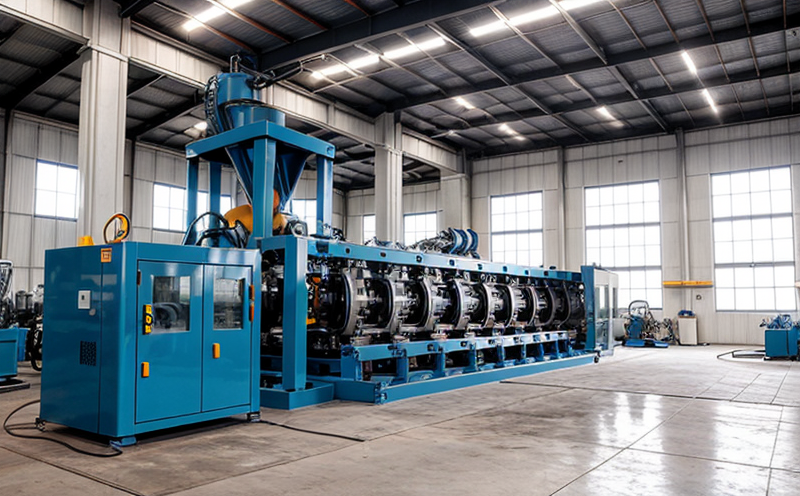ISO 9927 Crane Inspection Performance Testing
The ISO 9927 standard is a crucial guide used by industrial manufacturing and processing facilities to ensure that cranes, which are vital equipment for lifting heavy materials in various sectors including construction, mining, and logistics, operate safely and efficiently. This service focuses on inspecting and testing these cranes based on the stringent requirements outlined in ISO 9927, ensuring compliance with international standards.
Crane inspection performance testing is not merely a formality; it's essential for maintaining safety, optimizing productivity, and preventing costly downtime. By adhering to this standard, facilities can ensure that their cranes meet all the necessary requirements, thereby enhancing reliability and reducing the risk of accidents or failures during operation.
The process involves several key steps: initial setup, inspection, testing, analysis, and reporting. Each step is critical in ensuring that the crane is fit for purpose and meets the stringent criteria set out by ISO 9927. The equipment used in this testing includes calibrated load cells, strain gauges, accelerometers, and other precision instruments to measure force, displacement, acceleration, and temperature.
During the inspection phase, all components of the crane are carefully examined for signs of wear or damage. This includes the hoisting machinery, control systems, and any structural elements that could affect the safety and performance of the crane. The testing process then involves subjecting the crane to various load conditions to assess its ability to handle these loads safely.
The results of this inspection are meticulously recorded and analyzed to determine whether the crane meets the specified criteria for safe operation. Reporting is an integral part of this service, providing a comprehensive overview of the crane's performance against ISO 9927 standards. This report serves as evidence that the facility has met the necessary requirements and can be shared with regulatory bodies or stakeholders.
The importance of this testing cannot be overstated. Non-compliance with ISO 9927 could lead to severe accidents, which not only endanger lives but also result in substantial financial losses due to property damage and potential legal liabilities. By ensuring compliance through rigorous inspection and testing, facilities can protect their workforce, minimize risks, and maintain a safe working environment.
This service is particularly beneficial for quality managers, compliance officers, R&D engineers, and procurement professionals who are responsible for maintaining the integrity of equipment in industrial settings. It provides them with peace of mind knowing that they are adhering to international best practices and can make informed decisions about their facilities' needs.
Scope and Methodology
| Aspect | Description |
|---|---|
| Initial Setup | This involves preparing the crane for testing, including ensuring that all necessary equipment is in place and calibrated. |
| Inspection | All components of the crane are inspected for signs of wear or damage. This includes hoisting machinery, control systems, and structural elements. |
| Loading Conditions | The crane is subjected to various load conditions to assess its ability to handle these loads safely. |
| Analysis | The results of the inspection and testing are analyzed to determine compliance with ISO 9927 standards. |
| Reporting | A comprehensive report is prepared detailing the findings and conclusions of the test. |
The methodology for performing this service strictly adheres to the guidelines provided in ISO 9927, ensuring that all tests are conducted with precision and accuracy. This approach guarantees that facilities receive reliable data and actionable insights into their crane's performance.
Benefits
Adhering to ISO 9927 Crane Inspection Performance Testing brings numerous benefits to industrial manufacturing and processing facilities:
Enhanced safety: Ensures that cranes operate within safe parameters, reducing the risk of accidents.
Improved efficiency: By identifying potential issues early, maintenance can be planned proactively, minimizing downtime.
Compliance with international standards: Demonstrates commitment to quality and safety, which is essential for regulatory compliance.
Increased productivity: Reliable cranes contribute to higher production rates by ensuring consistent performance.
Cost savings: Early detection of issues can prevent costly repairs or replacements down the line.
Enhanced reputation: Demonstrating adherence to international standards can improve a facility's image and attract new business opportunities.
In summary, ISO 9927 Crane Inspection Performance Testing is an indispensable service for industrial facilities looking to optimize their operations while maintaining the highest levels of safety and compliance.
International Acceptance and Recognition
ISO 9927 is internationally recognized as the standard for crane inspection performance testing, ensuring consistency across different regions and industries.
Countries such as Australia, Canada, the European Union, Japan, South Africa, and the United States have adopted ISO standards, including ISO 9927, to ensure safety in heavy lifting operations.
Recognition by international bodies like the International Organization for Standardization (ISO) guarantees that this service is based on the latest industry best practices.
The standard's acceptance in key markets indicates its relevance and value across diverse industrial sectors.
This widespread recognition underscores the importance of adhering to ISO 9927 for any facility involved in heavy lifting operations. It ensures that facilities are up-to-date with global standards, thereby enhancing their operational reliability and safety.





